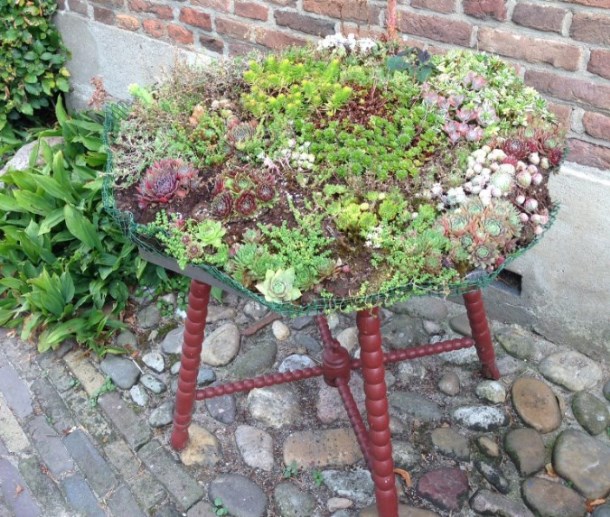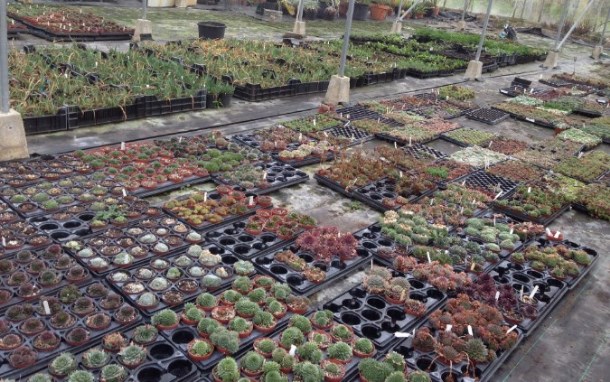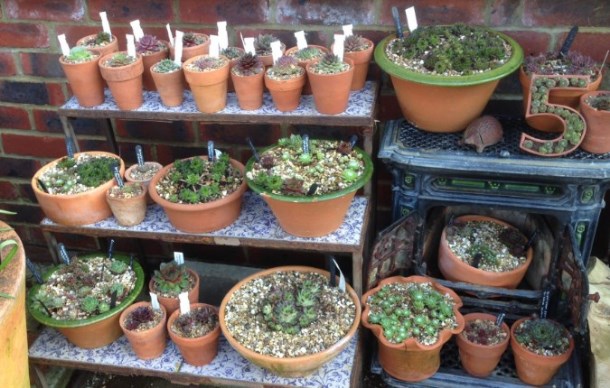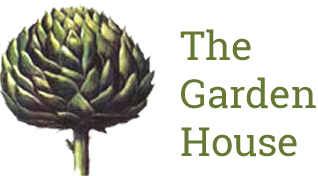We love Sempervivums: 10 Reasons Why!
Posted:14 September 2014
At the Garden House we love Sempervivums (houseleeks). Here are 10 reasons why:
They are small. Basically, a Sempervivum is a rosette-shaped hardy perennial succulent about the size of a jammy dodger. (Actually, some are bigger than that – picture a blueberry muffin, even a choc chip cookie. You get the idea.) They can be grown – and will thrive – in the smallest clay pots. So if you only have a doorstep, balcony, or window ledge, as long as it’s sunny you can still grow lots of semps.
They are tough. Sempervivum means ever living. It’s not a cast-iron guarantee but unlike many other succulents semps are hardy. They do need protection from excessive winter wet a good layer of grit, pushing it in under the collar of the rosette, helps but mine live outside all year and come to little harm.
They are easy to grow. Give them a sunny spot and excellent drainage and that’s all they need. A compost mix of John Innes No 1 or 2 plus 25% grit is ideal. Plant nurseries may feed semps occasionally to bulk them up but it isn’t necessary. They thrive in poor conditions. S. tectorum is traditionally grown between roof tiles to keep them in place and ward off lightning (the latter unproven). You can plant them in poor dry garden soil at the edge of sunny borders or paths but make sure other plants do not spread over them.

They are pretty. Semps come in shades of pink, lilac, bright red, ruby, brown, grey, grey-green, blue, blue-green, jade and lime. Visit a specialist nursery or look on-line and you will see collections of semps like a selection box of chocolates or a display of fondants or pastel macaroons! And these are just the leaves, not the flowers, so you keep the colours all year round.
They hybridise readily. So if you become obsessed with this particular plant – easily done you will find lots of varied forms to add to your collection. I have more than 50 in my tiny garden at home. There are about 40 different species, and hundreds of cultivars, some with very little to differentiate them (but that has never held back snowdrop enthusiasts.) Leaves may be matte, glossy, waxy, or covered with fine silvery hairs. S. arachnoideum and cultivars have white filaments like cobwebs across the centre of the rosettes. Some, like S. ‘Reinhard’, have dark-tipped leaves. S. ‘Kramer’s Spinrad’ is green with reddish flecks. Many seem to change colour according to growing conditions, light levels etc, so the same named form may look different at different times of the year or stage of growth. The varied colours make a great contrast either in groups of pots or in the same container.
They are easy to propagate. In fact, they do it themselves. Another common name for them is Hens-and-chickens. Each rosette produces small offsets that cluster tightly round the mother plant or reach out on fleshy extensions. These can be detached up and potted up separately – easiest if they are showing fine aerial roots. If you have top-dressed with grit they will root readily in this.
They are generous. Because of Point 6. above, you will always have more semps to swap, sell, donate, and generally spread the love. Although monocarpic – the central rosette throws up a flower stalk and then dies – with luck it will already have produced plenty of replacements. Remove the dead rosette and the baby plants will spread to fill the gap.

They are ideal for containers. As long as the container has good drainage and the soil is not too deep (put a thick layer of grit, crocks or polystyrene in the base) you can be very creative. Lots of inspiration is available in books and on-line. Sempervivums are mat-forming and architectural, and will fill odd shapes and ‘flow’ down the sides or cracks. As well as in pots, they do well in alpine sinks, on green roofs, and in dry walls.
They are cheap. Probably because they are – as above small, tough, undemanding, and easy to propagate. The opposite of the delicate divas of the plant world! So you can indulge your plant fever without spending much. Canny sempervivophiles (I just made that word up) choose the plants with loads of babies already attached.
They have few pests and diseases. Slugs and snails may sometimes chomp at the leaves, mainly of the softer-textured types. But top-dressing with grit, growing them in full sun on garden tables, wall tops and ledges, means they are out of the way of molluscs’ preferred conditions. Though in my experience nothing deters a slug or snail from going where it wants to! Semps may suddenly succumb to wet and collapse and die; I’ve found those with longer sword-shaped leaves more likely to do so. The dark-tipped spiny ones seem very self-reliant. They do need some water, though. Unlike greenhouse/conservatory succulents which can last for ages when totally dry, semps will go brown and crisp and die off from the outside edges inwards if left where the rain can’t penetrate at all. If grown in a greenhouse they can get greenfly, but simply putting them outside in the weather will solve the problem.
The Garden House has a large collection of sempervivums. We hope we have tempted you to give these plants a try.
Words by our good friend and fellow gardener Julia Widdows.


